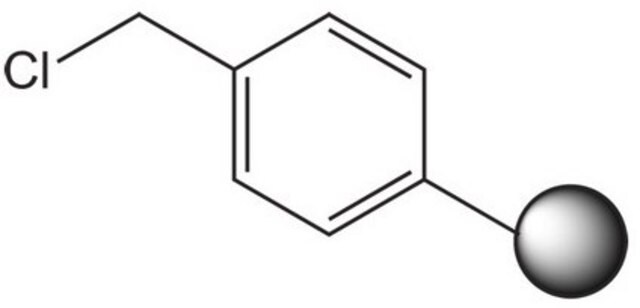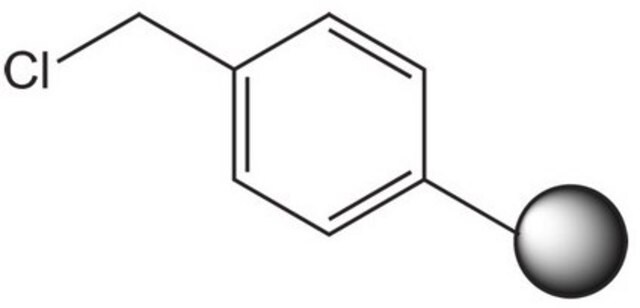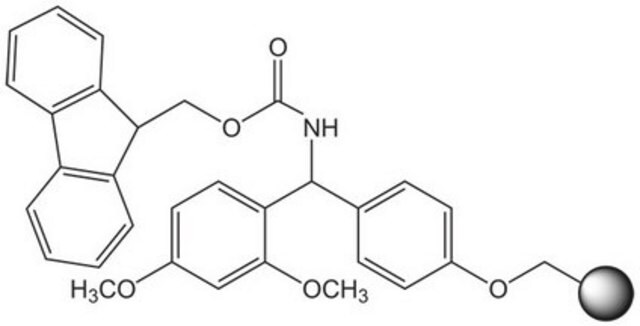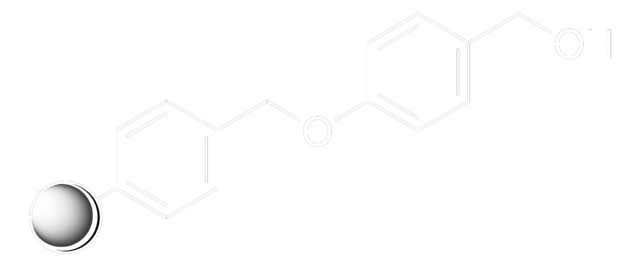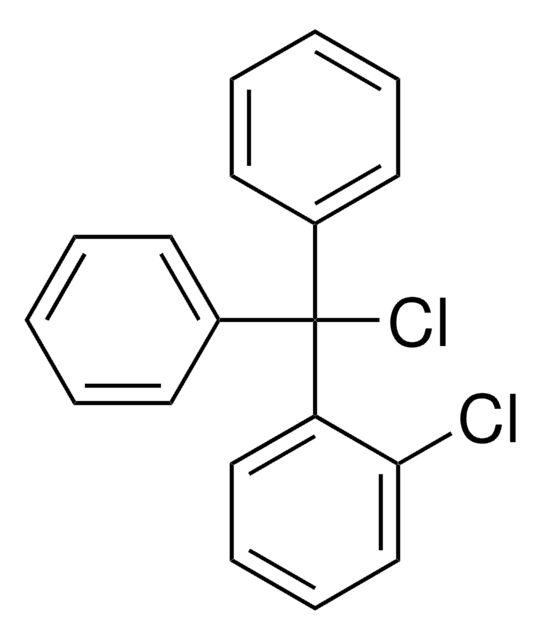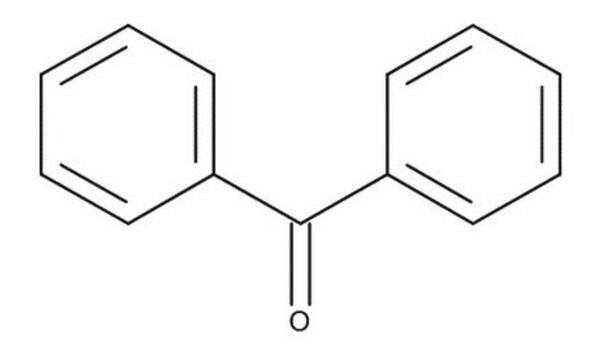8.55012
Trityl chloride resin
Novabiochem®
Se connecterpour consulter vos tarifs contractuels et ceux de votre entreprise/organisme
About This Item
Code UNSPSC :
12352101
Produits recommandés
Gamme de produits
Novabiochem®
Forme
beads
Capacité de réaction
reaction type: Fmoc solid-phase peptide synthesis
Fabricant/nom de marque
Novabiochem®
Application(s)
peptide synthesis
Température de stockage
2-30°C
Description générale
An acid-labile resin for the solid phase immobilization of alcohols [1,2,3,4,5], amines [4, 6,7,8,9,10,11,12], sugars [13], O- and N-linked hydroxylamines [14,15], imidazoles [16] and carboxylic acids [16]. Release of these functionalities is generally achieved using 1-5% TFA in DCM containing 5% TIS. Amines can also be cleaved with 30% HFIP in DCM [4]. This resin, although very acid sensitive, can also be used in peptide synthesis [17].
Associated Protocols and Technical Articles
Protocols for Loading of Peptide Synthesis Resins
Literature references
[1] C. C. Leznoff (1978) Acc. Chem. Res., 11, 327.
[2] C. Chen, et al. (1994) J. Am. Chem. Soc., 116, 2661.
[3] Z. Li & A. Ganesan (1998) Syn. Lett., 405.
[4] P. Athanassopoulos, et al., Poster 316 presented at the 24thEuropean Peptide Symposium, Edinburgh, 1996.
[5] K. Barlos, et al. (1988) Liebigs Ann. Chem., 1079.
[6] K. Barlos, et al. in ′Peptides 1992, Proc. 22nd European Peptide Symposium′, C. H. Schneider & A. N. Eberle (Eds), ESCOM, Leiden,1993, pp. 281.
[7] M. Schuster, et al. (1996) Angew. Chem. Int. Ed. Engl., 35, 1979.
[8] P. Garibay, et al. (1998) Tetrahedron Lett., 39, 2207.
[9] Y. Guan, et al. (2000) J. Comb. Chem., 2, 297.
[10] S. Manku, et al. (2001) J. Org. Chem., 66, 874.
[11] D. Jönsson, et al. (2001) Tetrahedron Lett., 42, 6953.
[12] C. A. Olsen, et al. (2003) Org. Lett., 5, 4183.
[13] F. Peri, et al. (2000) Tetrahedron Lett., 41, 8587.
[14] U. Bauer, et al. (1997) Tetrahedron Lett., 38, 7233.
[15] O. Kinzel, et al. (2003) J. Peptide Sci., 9, 375.
[16] D. P. Matthews, et al. (2000) J Comb. Chem., 2,19.
[17] K. Barlos, et al. (1989) Tetrahedron Lett., 30, 3943.
Associated Protocols and Technical Articles
Protocols for Loading of Peptide Synthesis Resins
Literature references
[1] C. C. Leznoff (1978) Acc. Chem. Res., 11, 327.
[2] C. Chen, et al. (1994) J. Am. Chem. Soc., 116, 2661.
[3] Z. Li & A. Ganesan (1998) Syn. Lett., 405.
[4] P. Athanassopoulos, et al., Poster 316 presented at the 24thEuropean Peptide Symposium, Edinburgh, 1996.
[5] K. Barlos, et al. (1988) Liebigs Ann. Chem., 1079.
[6] K. Barlos, et al. in ′Peptides 1992, Proc. 22nd European Peptide Symposium′, C. H. Schneider & A. N. Eberle (Eds), ESCOM, Leiden,1993, pp. 281.
[7] M. Schuster, et al. (1996) Angew. Chem. Int. Ed. Engl., 35, 1979.
[8] P. Garibay, et al. (1998) Tetrahedron Lett., 39, 2207.
[9] Y. Guan, et al. (2000) J. Comb. Chem., 2, 297.
[10] S. Manku, et al. (2001) J. Org. Chem., 66, 874.
[11] D. Jönsson, et al. (2001) Tetrahedron Lett., 42, 6953.
[12] C. A. Olsen, et al. (2003) Org. Lett., 5, 4183.
[13] F. Peri, et al. (2000) Tetrahedron Lett., 41, 8587.
[14] U. Bauer, et al. (1997) Tetrahedron Lett., 38, 7233.
[15] O. Kinzel, et al. (2003) J. Peptide Sci., 9, 375.
[16] D. P. Matthews, et al. (2000) J Comb. Chem., 2,19.
[17] K. Barlos, et al. (1989) Tetrahedron Lett., 30, 3943.
Liaison
Replaces: 01-64-0074
Remarque sur l'analyse
Color (visual): white to yellow to beige
Appearance of substance (visual): beads
Loading (determined from the substitution of the Fmoc-Ala-Leu loaded resin): 1.1 - 1.7 mmol/g
Swelling Volume (in CH₂Cl₂): lot specific result
The polymer matrix is copoly (styrene-1 % DVB), 200 - 400 mesh
Appearance of substance (visual): beads
Loading (determined from the substitution of the Fmoc-Ala-Leu loaded resin): 1.1 - 1.7 mmol/g
Swelling Volume (in CH₂Cl₂): lot specific result
The polymer matrix is copoly (styrene-1 % DVB), 200 - 400 mesh
Informations légales
Novabiochem is a registered trademark of Merck KGaA, Darmstadt, Germany
Code de la classe de stockage
11 - Combustible Solids
Classe de danger pour l'eau (WGK)
WGK 1
Point d'éclair (°C)
Not applicable
Certificats d'analyse (COA)
Recherchez un Certificats d'analyse (COA) en saisissant le numéro de lot du produit. Les numéros de lot figurent sur l'étiquette du produit après les mots "Lot" ou "Batch".
Déjà en possession de ce produit ?
Retrouvez la documentation relative aux produits que vous avez récemment achetés dans la Bibliothèque de documents.
Les clients ont également consulté
Notre équipe de scientifiques dispose d'une expérience dans tous les secteurs de la recherche, notamment en sciences de la vie, science des matériaux, synthèse chimique, chromatographie, analyse et dans de nombreux autres domaines..
Contacter notre Service technique

